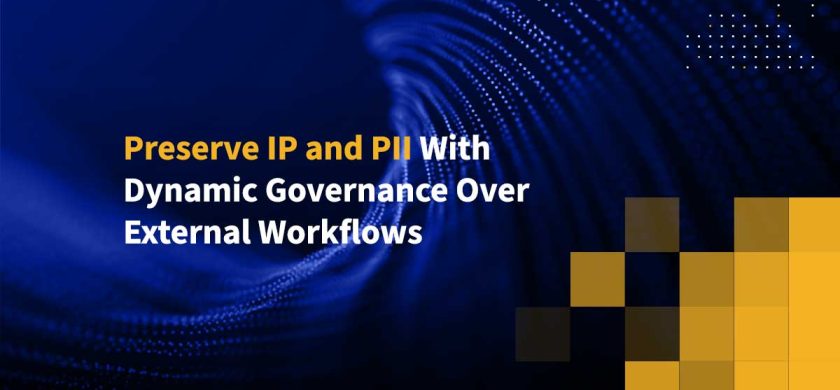
Preserve IP and PII With Dynamic Governance Over External Workflows
Internal file threats entail a breach of sensitive information from secure content stores to unauthorized third parties. To prevent them, you must ensure that all sensitive files are saved to the correct repository, and then tightly control who, when and how files can be retrieved. Assuming you have shrunk the threat surface with enterprise content integration, making it safe and easy for users to save and retrieve files, then the next step is to inspect every attempted retrieval and block unauthorized requests.
The modern enterprise spends millions of dollars on cyber security, yet the modern CISO can't say in any specific detail what information is entering and leaving the firm. If you can't see it, you can't defend it. Everyday workflows where employees exchange sensitive information with external parties expose the firm to constant threats, including leaks, phishing, malicious files, and compliance violations. These external workflow threats have a common theme: a user is the actor, and a file is the agent. Complete protection requires a defense that spans the full breadth of the associated threat surface: the collective paths of all files entering and leaving your organization.  In my last blog post, we discussed hardening the threat surface by restricting access to sensitive data. Today, I'll discuss defending the threat surface against data breaches by employing tight governance over all file transfers.
In my last blog post, we discussed hardening the threat surface by restricting access to sensitive data. Today, I'll discuss defending the threat surface against data breaches by employing tight governance over all file transfers.
Limit Content Access and Analyze File Transfer Metadata
Enterprise content access should be tightly governed with highly granular user-level permissions that ensures data privacy. The most sensitive content should be segregated, so that additional security measures can be easily applied, such as multi-factor authentication. This is all standard best practice. However, a CISO Dashboard that monitors the entire file transfer path—the end-to-end threat surface—enables real-time application of stronger security measures based on transfer metadata, such as sender, receiver, origin, destination, and time of transfer.
Deploy Data Loss Prevention as an Additional Line of Defense
On a file-by-file basis, DLP can be deployed to deny unauthorized requests based on the content. This process can be accelerated by implementing a data classification standard that allows DLP scans to be performed offline and requests for sensitive content to be processed in real-time. This type of context-aware, content aware dynamic security and governance can only be applied along the natural threat surface of external workflows: users, applications and files. It is impossible to apply it at the network and physical layers, because the relevant data is either unavailable or encrypted. In the next post, I'll discuss defending the threat surface against external threats by inspecting every file to block malicious attacks. Future posts will cover concepts like building a holistic, proactive defense that spans the entire threat surface.
To learn more about defending the threat surface against data breaches by employing tight governance over all file transfers, schedule a custom demo of Kiteworks today.
Frequently Asked Questions
Third-party risk management is a strategy that organizations implement to identify, assess, and mitigate risks associated with their interactions with third-party vendors, suppliers, or partners. These risks can range from data breaches and security threats to compliance issues and operational disruptions. The process typically involves conducting due diligence before engaging with a third party, continuously monitoring the third party’s activities and performance, and implementing controls to manage identified risks. The goal is to ensure that the third party’s actions or failures do not negatively impact the organization’s operations, reputation, or legal obligations.
Third-party risk management is crucial because it helps to identify, assess, and mitigate the risks associated with third-party relationships. This can include cybersecurity threats, compliance issues, operational risks, and reputational damage.
Policy controls are essential in third-party risk management as they establish clear expectations for third-party behavior, data handling, and security practices. They help mitigate the risk of security incidents by defining acceptable actions, and ensure third parties comply with relevant laws, regulations, and industry standards. Further, policy controls provide a foundation for monitoring third-party activities and enforcing compliance, allowing the organization to take appropriate action in case of policy violations. Thus, policy controls serve as a critical framework for managing third-party risks effectively.
Audit logs are integral to third-party risk management as they offer a comprehensive record of all third-party activities within your systems. They aid in identifying potential risks by highlighting unusual or suspicious activities, serve as a crucial resource during incident response and forensic investigations, and help ensure regulatory compliance by providing proof of effective security measures and third-party monitoring. In addition, they foster a culture of accountability and transparency among third parties, deterring malicious activities and encouraging adherence to security policies.
Kiteworks helps with third-party risk management by providing a secure platform for sharing and managing sensitive content. The platform is designed to control, track, and secure sensitive content that moves within, into, and out of an organization, significantly improving risk management. Kiteworks also provides two levels of email encryption, Enterprise and Email Protection Gateway (EPG), to secure sensitive email communications. This helps to protect against third-party risks associated with email communication.
Additional Resources
- Blog Post PII Compliance Requirements
- Blog Post Data Sovereignty Laws
- Blog Post 3rd Party Risk Management
- Blog Post Security Governance
- Blog Post Information Governance